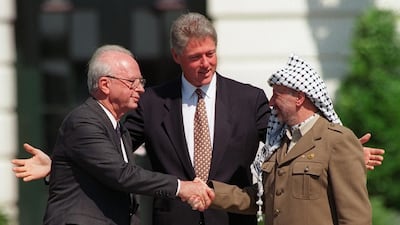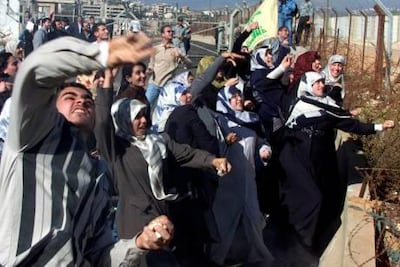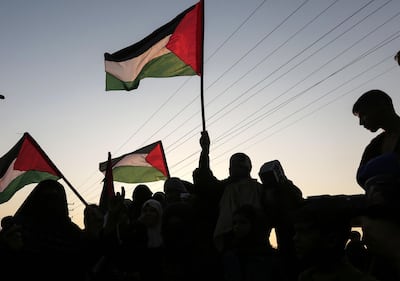Today marks the 25th anniversary of the Oslo Accords, when then Israeli foreign minister Shimon Peres and Palestinian leader Yasser Arafat signed an agreement outlining a timeframe for a lasting Middle Eastern peace process. In a now infamous photo, Arafat and then Israeli prime minister Yitzhak Rabin shook hands on September 13, 1993, on the lawns of the White House, overlooked by a congratulatory Bill Clinton. The accords saw Arafat, Rabin and Peres awarded the Nobel Peace Prize the following year.
Yet when the history of the Israeli-Palestinian conflict is finally written in full, the Oslo period will go down as one of its darkest chapters.
Far from its promise of a two-state solution, the legacy of the Oslo Accords is little more than the steady advancement of Israeli interests and Palestinian fragmentation.
Since the agreement came into effect, Israel has rapidly deepened its West Bank settlement project while taking active measures to ensure geographic and political division among Palestinians. Israel’s matrix of control over Palestinian life is all but complete as its domination goes virtually unchallenged.
With an eager partner in the White House and the two-state solution dying – if not already dead – Israel has thrust the conflict into a dangerous new phase, in which key Palestinian demands are simply removed from the negotiation table. Such moves would have been unthinkable when Oslo was crafted and that highlights how the accords have been deftly used to Israeli ends.
The lofty promise of Oslo was, of course, branded very differently to what the reality on the ground portrays today. As a set of agreements signed between Israel and the Palestine Liberation Organisation (PLO), the accords created a set of milestones to pave the road to a Palestinian state. The Palestinian Authority, one of the crowning benchmarks, was created as an interim project in Palestinian self-governance.
The West Bank and Gaza Strip, while still under Israeli occupation, were divided into geographic chunks, with various types of jurisdiction split between Israeli and Palestinian security forces. Area C, which constitutes the vast majority of Palestinian land and includes all Israeli settlements, was left securely in Israeli hands. Area A, which encompasses the largest Palestinian cities such as Ramallah and Nablus, was handed to Palestinian security forces, who were trained and directed by Israeli and American handlers. Area B was designated as Palestinian civil control and joint Israeli-Palestinian security control. In practice, all of these distinctions were meaningless as Israel exercised its authority at will.
While the road to peace might have been paved with good intentions from the international community, the reality is that Israel never ceased its occupation, ceded any form of legitimate control to the Palestinians nor acted in good faith on the basic pretext of the accords. In fact, Israeli settlement activity exploded in the years following Oslo.

From the perspective of advancing Israel’s long-term interests, the Oslo period has been a remarkable success. Not only did Tel Aviv gain international goodwill but it has been able to achieve its long-term goal of “changing the facts” on the ground by making its occupation a permanent fixture on the landscape. Considering the era in which the accords were crafted and signed, this success should not come as a surprise.
The early 1990s were a period of historic transformation. The first Palestinian intifada, which took Israel by surprise, given its civilian and largely unarmed make-up, had recently been crushed by Tel Aviv.
At the same time, the apartheid regime in South Africa had all but fallen apart as Nelson Mandela’s African National Congress forced the country into an experiment with democracy. Thanks to archival records in South Africa, we know that Israeli authorities studied the end of apartheid in South Africa in the hopes of learning from the regime’s mistakes and not repeating them in their own relationship with the Palestinians.
It is in this climate that Israel itself initiated the Oslo peace process. To be sure, the PLO at this stage was woefully out of touch with the reality of life under occupation. Palestinian activists in the West Bank and Gaza Strip led an intifada structured around the idea of rights.
Statehood was, at best, a secondary concern for those living under Israeli control. And yet, the architects of Oslo focused on statehood at the expense of a rights-based discourse.
This is a critical but often overlooked footnote of the Oslo story, as historically nothing has frightened Israel more than united and unarmed Palestinians demanding rights. Such an approach helped bring an end to apartheid in South Africa, the Rhodesian regime and French colonisation in Algeria. Pick any contemporary colonial episode and you will find the fear of rights-based protest.
Taken from this perspective, the Oslo Accords were a clear attempt to shift the discourse away from rights to statehood and security. Ultimate justice for Palestinians, as the architects of the accords framed it, was an independent Palestinian state. With the benefit of hindsight, we now understand that Israel was never going to allow such an outcome but the discourse of statehood played straight into Tel Aviv's public relations campaign.
The Palestinian Authority, an essentially unelected body controlled by Israel, became the representative of the Palestinian state in the eyes of the world's media. The plight of a West Bank farmer or village losing their land due to expanding Israeli settlements mattered little (and thus received little media coverage) because such a story did not fit with the security narrative that we use to describe the needs of a state.
The conflict transformed into one in which Israel and Palestine were relative equals, each striving for peace and security within their respective borders. The reality, however, was very different. The conflict actually was – and still is – one in which Israel occupies all of Palestine and continues to entrench its domination of Palestinian life. As the Oslo talks dragged on, the occupation quietly drifted away as the key facet of the conflict and was replaced by the security narrative we know today.
Indeed, one of Oslo’s many faults was that it failed to recognise Israel’s control over the entire land area between the Mediterranean Sea and Jordan River. Land crossings, airspace and maritime borders were left in Israeli hands to be “negotiated at a later time”.
Furthermore, Israel violated the letter of the Oslo Accords and conducted military raids and operations inside areas nominally under Palestinian control. Looking back, such realities reveal how the accords were destined to fail from the start.
In the 25 years since that fateful handshake between Arafat and Rabin in the grounds of the White House, the reality on the ground for Palestinians has never been bleaker. While never operating as a genuine peace broker, the United States did pay lip service to legitimate needs on both sides.
That is no longer the case since US President Donald Trump decided the best way to solve the conflict was to unilaterally side with Israeli demands. This strategy is certainly abrasive but is it really that different in complexion to the approaches of previous US administrations?
The Oslo Accords are dead. They served to advance, entrench and protect Israel’s occupation and we can thus mourn their passing with a sense of hope on the horizon. The rights-based discourse survives as it has throughout other conflicts from Africa to India.
The next chapter in Israel-Palestine has already started and, despite its verbose rhetoric, the Palestinian desire to live with rights will not be silenced nor fade. If Palestinians can survive Oslo, they can survive anything.
Joseph Dana is the editor of emerge85, a project exploring change in the emerging world and its global impact




